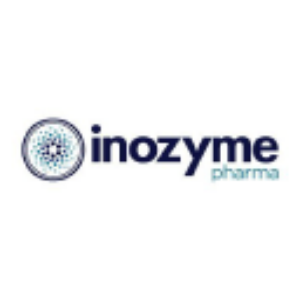Inozyme Pharma Reports Third Quarter 2023 Financial Results and Provides Business Highlights
– Patient recruitment underway in ENERGY-3 Pivotal Trial of INZ-701 in pediatric patients with ENPP1 Deficiency; topline data expected mid-2025 –
– Topline data readouts from ongoing Phase 1/2 trials of INZ-701 in adults with ABCC6 Deficiency and ENPP1 Deficiency expected in first quarter of 2024 –
– Cash, cash equivalents, and short-term investments as of September 30, 2023 expected to fund operations into the fourth quarter of 2025 –
BOSTON, Nov. 07, 2023 (GLOBE NEWSWIRE) -- Inozyme Pharma, Inc. (Nasdaq: INZY) (“Inozyme” or the “Company”), a clinical-stage rare disease biopharmaceutical company developing novel therapeutics for the treatment of pathologic mineralization and intimal proliferation, today reported financial results for the third quarter ended September 30, 2023 and provided business highlights.
“We are excited to advance INZ-701 into the ENERGY-3 pivotal trial in pediatric patients with ENPP1 Deficiency. Our ongoing trial of INZ-701 in adults with ENPP1 Deficiency showed early signs of clinical impact and supports the potential of treating children with this condition,” said Douglas A. Treco, Ph.D., CEO of Inozyme Pharma. “We continue to expand our pipeline and therapeutic focus with INZ-701,” Dr. Treco added. “In addition to planning a Phase 3 trial in patients with ABCC6 Deficiency, recent data presented by our collaborators at the American Society of Nephrology Kidney Week 2023 support our plans to evaluate INZ-701 in patients with calciphylaxis, a rare but often fatal complication of hemodialysis associated with end-stage kidney disease.”
Recent Highlights
- ENERGY-3 Pivotal Trial of INZ-701 in Pediatric Patients with ENPP1 Deficiency. Patient recruitment is underway, and the Company remains on track to report topline data in mid-2025.
- Phase 1/2 Clinical Trial of INZ-701 in Adults with ENPP1 Deficiency. The Company announced positive interim safety, pharmacokinetic (PK), pharmacodynamic (PD), and exploratory efficacy data from the ongoing trial. Exploratory efficacy data reported suggested clinical benefit for ENPP1 Deficiency, including improvement in key biomarkers, patient-reported outcomes (PROs), and functional outcomes. Dosing is ongoing in the Phase 2 portion of the trial, and the Company is on track to report topline clinical data from the first three cohorts through 48 weeks in the first quarter of 2024.
- Phase 1/2 Clinical Trial of INZ-701 in Adults with ABCC6 Deficiency (pseudoxanthoma elasticum, or PXE). The Company announced positive interim safety, PK, PD, and exploratory efficacy data from the ongoing trial. Improvements in the Global Impression of Change (GIC), a PRO, were observed in all three dose cohorts. Dosing is ongoing in the Phase 2 portion of the trial, and the Company is on track to report topline clinical data through 48 weeks in the first quarter of 2024.
- Genomics England Generation Study. The Company highlighted the inclusion of Generalized Arterial Calcification of Infancy (GACI), which is caused by mutations in the ENPP1 or ABCC6 genes, in the Genomics England’s Generation Study. The Generation Study is scheduled to begin in late 2023, with the goal of sequencing the genomes of more than 100,000 infants and paving the way for potential widespread implementation of whole-genome sequencing in newborn screening.
- Medical Conference Presentations. The Company announced the presentation of three posters at the American Society for Bone and Mineral Research (ASBMR) 2023 Annual Meeting and an oral presentation at the American Society for Nephrology (ASN) Kidney Week 2023.
Anticipated Milestones
- ENPP1 Deficiency
- Topline data from first three cohorts of ongoing Phase 1/2 trial in adults through 48 weeks – Q1 2024
- Initiation of the ENERGY-2 pivotal trial in infants, Ex-U.S. – Q2 2024
- Interim data from the ENERGY-1 Phase 1b trial in infants – 2H 2024
- Topline data from the ENERGY-3 pivotal trial in pediatric patients – Mid-2025
- ABCC6 Deficiency
- Topline data from ongoing Phase 1/2 trial in adults through 48 weeks– Q1 2024
- Initiation of Phase 3 clinical trial in adults, subject to regulatory review and sufficient funding – Q4 2024
- Calciphylaxis
- Initiation of SEAPORT-1 Phase 1 trial designed to assess safety, tolerability, PK, and PD of INZ-701 in patients with end-stage kidney disease (ESKD) receiving hemodialysis – 1H 2024
- Interim data from SEAPORT-1 Phase 1 trial in patients with ESKD receiving hemodialysis – Q4 2024
Third Quarter 2023 Financial Results
- Cash Position and Financial Guidance. Cash, cash equivalents, and short-term investments were
$192.4 million as of September 30, 2023. Based on its current plans, the Company anticipates its cash, cash equivalents, and short-term investments as of September 30, 2023 will enable the Company to fund cash flow requirements into Q4 2025.
- Research and Development (R&D) Expenses. R&D Expenses were
$13.3 million for the quarter ended September 30, 2023, compared to$12.2 million for the prior-year period.
- General and Administrative (G&A) Expenses. G&A expenses were
$4.7 million for each of the quarters ended September 30, 2023 and 2022.
- Net Loss. Net loss was
$16.6 million , or$0.29 loss per share, for the quarter ended September 30, 2023, compared to$16.4 million , or$0.38 loss per share, for the prior-year period.
About ENPP1 Deficiency
ENPP1 Deficiency is a progressive condition that manifests as a spectrum of diseases. Individuals who present in utero or in infancy are typically diagnosed with generalized arterial calcification of infancy (GACI), which is characterized by extensive vascular calcification and intimal proliferation (overgrowth of smooth muscle cells inside blood vessels), resulting in myocardial infarction, stroke, or cardiac or multiorgan failure. Approximately
ENERGY-3 Pivotal Trial of INZ-701 in Pediatric Patients with ENPP1 Deficiency
The ENERGY-3 pivotal trial is a multicenter, randomized, open-label trial in pediatric patients with ENPP1 Deficiency. The trial is expected to enroll up to 33 patients between the ages of one and less than 13 years across multiple sites globally and is designed primarily to assess the efficacy and safety of INZ-701 in pediatric patients with ENPP1 Deficiency. Enrollment criteria for the trial include a confirmed genetic diagnosis of ENPP1 Deficiency, radiographic evidence of skeletal abnormalities, and low plasma pyrophosphate (PPi). Patients will be randomized in a 2:1 ratio to an INZ-701 arm or a control arm (conventional therapy, i.e., oral phosphate and active vitamin D) for 52 weeks, followed by an open-label extension period during which all patients may receive INZ-701. INZ-701 will be administered at a 2.4 mg/kg once weekly dose via subcutaneous injection. Based on recommendations from the Food and Drug Administration (FDA), the primary endpoint of plasma PPi should be supported by consistent trends in appropriate secondary endpoints such as Radiographic Global Impression of Change (RGI-C), Rickets Severity Score (RSS), and Growth Z-score. Based on the agreed Paediatric Investigational Plan (PIP) with the Paediatric Committee of the European Medicines Agency (PDCO), plasma PPi and RGI-C are co-primary endpoints, with a relaxed p-value of <0.2 for RGI-C.
Phase 1/2 Clinical Trial of INZ-701 in Adults with ENPP1 Deficiency
The ongoing Phase 1/2 open-label clinical trial initially enrolled nine adult patients with ENPP1 Deficiency at sites in North America and Europe. The trial will primarily assess the safety and tolerability of INZ-701 in adult patients with ENPP1 Deficiency, as well as characterize the pharmacokinetic (PK) and pharmacodynamic (PD) profile of INZ-701, including evaluation of the PD marker, plasma pyrophosphate (PPi) and other biomarker levels. In the Phase 1 dose-escalation portion of the trial, Inozyme assessed INZ-701 for 32 days at doses of 0.2 mg/kg, 0.6 mg/kg, and 1.8 mg/kg administered via subcutaneous injection twice weekly, with three patients per dose cohort. Doses were selected based on preclinical studies and PK/PD modeling. The Phase 1 dose-escalation portion of the trial sought to identify a safe, tolerable dose that increases PPi levels and that can be used for further clinical development. Following completion of the Phase 1 portion of the first three cohorts, Inozyme dosed patients in a fourth cohort at 1.2 mg/kg to investigate the potential for once-weekly dosing of INZ-701. The open-label Phase 2 extension portion of the trial is assessing long-term safety, PK, and PD of continued treatment with INZ-701 for at least 48 weeks, where patients may self-administer INZ-701. Exploratory endpoints include evaluations of skeletal, vascular, physical function, and patient-reported outcomes.
About ABCC6 Deficiency
ABCC6 Deficiency is a rare, severe, inherited disorder caused by mutations in the ABCC6 gene, leading to low levels of plasma pyrophosphate (PPi). PPi is essential for preventing harmful soft tissue calcification and regulating bone mineralization. ABCC6 Deficiency is a systemic and progressively debilitating condition which affects more than 67,000 individuals worldwide. Infants with ABCC6 Deficiency are diagnosed with generalized arterial calcification of infancy (GACI) type 2, a condition that resembles GACI type 1, the infant form of ENPP1 Deficiency. In older individuals, ABCC6 Deficiency presents as pseudoxanthoma elasticum (PXE), which is characterized by pathological mineralization in blood vessels and soft tissues clinically affecting the skin, eyes, and vascular system. There are no approved therapies for ABCC6 Deficiency.
Phase 1/2 Clinical Trial of INZ-701 in Adults with ABCC6 Deficiency
The ongoing Phase 1/2 open-label clinical trial enrolled 10 adult patients with ABCC6 Deficiency at sites in the United States and Europe. The trial will primarily assess the safety and tolerability of INZ-701 in adult patients with ABCC6 Deficiency, as well as characterize the pharmacokinetic (PK) and pharmacodynamic (PD) profile of INZ-701, including the evaluation of levels of plasma pyrophosphate (PPi) and other biomarkers. In the Phase 1 dose-escalation portion of the trial, Inozyme assessed INZ-701 for 32 days at doses of 0.2 mg/kg, 0.6 mg/kg, and 1.8 mg/kg administered via subcutaneous injection twice weekly, with three patients per dose cohort. Doses were selected based on preclinical studies and PK/PD modeling. The Phase 1 dose-escalation portion of the trial sought to identify a safe, tolerable dose that increases PPi levels for further development. The open-label Phase 2 extension portion of the trial is assessing long-term safety, PK, and PD of continued treatment with INZ-701 for at least 48 weeks, where patients may self-administer INZ-701. Exploratory endpoints will include evaluations of vascular, ophthalmologic, physical function, and patient-reported outcomes.
About Calciphylaxis
Calciphylaxis is a serious and rare disorder with a high mortality rate that mostly affects patients with end-stage kidney disease (ESKD). The disease is associated with low levels of plasma pyrophosphate (PPi) and is characterized by pathologic mineralization and intimal proliferation of the vasculature in the skin and fatty tissue, leading to blood clots, painful skin ulcers, infections, and death. Patients with calciphylaxis have a reported one-year survival rate of approximately
About INZ-701
INZ-701, a recombinant Fc fusion protein, is an ENPP1 enzyme replacement therapy in development for the treatment of rare disorders of the vasculature, soft tissue, and skeleton. In preclinical studies, the experimental therapy has shown potential to prevent pathologic mineralization and intimal proliferation (the overgrowth of smooth muscle cells inside blood vessels), which can drive morbidity and mortality in devastating genetic disorders such as ENPP1 Deficiency and ABCC6 Deficiency. INZ-701 is currently in multiple clinical trials for the treatment of ENPP1 Deficiency and ABCC6 Deficiency.
About Inozyme Pharma
Inozyme Pharma, Inc. is a clinical-stage rare disease biopharmaceutical company developing novel therapeutics for the treatment of diseases impacting the vasculature, soft tissue, and skeleton. Inozyme is developing INZ-701, an enzyme replacement therapy, to address pathologic mineralization and intimal proliferation which can drive morbidity and mortality in these severe diseases. INZ-701 is currently in multiple clinical trials for the treatment of ENPP1 Deficiency and ABCC6 Deficiency.
For more information, please visit www.inozyme.com or follow Inozyme on LinkedIn, X (formerly Twitter), and Facebook.
Cautionary Note Regarding Forward-Looking Statements
Statements in this press release about future expectations, plans, and prospects, as well as any other statements regarding matters that are not historical facts, may constitute "forward-looking statements" within the meaning of The Private Securities Litigation Reform Act of 1995. These statements include, but are not limited to, statements relating to the timing and design of our clinical trials, the availability and timing of data from clinical trials, the potential benefits of INZ-701, and the period over which we believe that our existing cash, cash equivalents, and short-term investments will be sufficient to fund our cash flow requirements. The words "anticipate," "believe," "continue," "could," "estimate," "expect," "intend," "may," "plan," "potential," "predict," "project," "should," "target," "will," "would," and similar expressions are intended to identify forward-looking statements, although not all forward-looking statements contain these identifying words. Any forward-looking statements are based on management's current expectations of future events and are subject to a number of risks and uncertainties that could cause actual results to differ materially and adversely from those set forth in, or implied by, such forward-looking statements. These risks and uncertainties include, but are not limited to, risks associated with the Company's ability to conduct its ongoing clinical trials of INZ-701 for ENPP1 Deficiency and ABCC6 Deficiency; enroll patients in ongoing and planned trials; obtain and maintain necessary approvals from the FDA and other regulatory authorities; continue to advance its product candidates in preclinical studies and clinical trials; replicate in later clinical trials positive results found in preclinical studies and early-stage clinical trials of its product candidates; advance the development of its product candidates under the timelines it anticipates in planned and future clinical trials; obtain, maintain, and protect intellectual property rights related to its product candidates; manage expenses; comply with covenants under its outstanding loan agreement; and raise the substantial additional capital needed to achieve its business objectives. For a discussion of other risks and uncertainties, and other important factors, any of which could cause the Company's actual results to differ from those contained in the forward-looking statements, see the "Risk Factors" section in the Company's most recent Annual Report on Form 10-K filed with the Securities and Exchange Commission, as well as discussions of potential risks, uncertainties, and other important factors, in the Company's most recent filings with the Securities and Exchange Commission. In addition, the forward-looking statements included in this press release represent the Company's views as of the date hereof and should not be relied upon as representing the Company's views as of any date subsequent to the date hereof. The Company anticipates that subsequent events and developments will cause the Company's views to change. However, while the Company may elect to update these forward-looking statements at some point in the future, the Company specifically disclaims any obligation to do so.
| Condensed Consolidated Balance Sheet Data (Unaudited) | |||||||
| September 30, 2023 | December 31, 2022 | ||||||
| Cash, cash equivalents and investments | $ | 192,442 | $ | 127,866 | |||
| Total assets | $ | 205,702 | $ | 139,195 | |||
| Total liabilities | $ | 45,489 | $ | 20,801 | |||
| Additional paid-in-capital | $ | 424,671 | $ | 333,356 | |||
| Accumulated deficit | $ | (264,386 | ) | $ | (214,761 | ) | |
| Total stockholders' equity | $ | 160,213 | $ | 118,394 | |||
| Condensed Consolidated Statements of Operations and Comprehensive Loss (Unaudited) | |||||||||||||||||
| Three Months Ended September 30, | Nine Months Ended September 30, | ||||||||||||||||
| 2023 | 2022 | 2023 | 2022 | ||||||||||||||
| Operating expenses: | |||||||||||||||||
| Research and development | $ | 13,341 | $ | 12,191 | $ | 36,864 | $ | 34,012 | |||||||||
| General and administrative | 4,733 | 4,721 | 15,973 | 15,130 | |||||||||||||
| Total operating expenses | 18,074 | 16,912 | 52,837 | 49,142 | |||||||||||||
| Loss from operations | (18,074 | ) | (16,912 | ) | (52,837 | ) | (49,142 | ) | |||||||||
| Other income (expense): | |||||||||||||||||
| Interest income, net | 1,416 | 737 | 3,254 | 1,118 | |||||||||||||
| Other expense, net | 20 | (197 | ) | (42 | ) | (493 | ) | ||||||||||
| Other income, net | 1,436 | 540 | 3,212 | 625 | |||||||||||||
| Net loss | $ | (16,638 | ) | $ | (16,372 | ) | $ | (49,625 | ) | $ | (48,517 | ) | |||||
| Other comprehensive income (loss): | |||||||||||||||||
| Unrealized gains (losses) on available-for-sale securities | 53 | (60 | ) | 279 | (417 | ) | |||||||||||
| Foreign currency translation adjustment | (182 | ) | (20 | ) | (152 | ) | (78 | ) | |||||||||
| Total other comprehensive income (loss) | (129 | ) | (80 | ) | 127 | (495 | ) | ||||||||||
| Comprehensive loss | $ | (16,767 | ) | $ | (16,452 | ) | $ | (49,498 | ) | $ | (49,012 | ) | |||||
| Net loss attributable to common stockholders—basic and diluted | $ | (16,638 | ) | $ | (16,372 | ) | $ | (49,625 | ) | $ | (48,517 | ) | |||||
| Net loss per share attributable to common stockholders—basic and diluted | $ | (0.29 | ) | $ | (0.38 | ) | $ | (1.02 | ) | $ | (1.36 | ) | |||||
| Weighted-average common shares and pre-funded warrants outstanding—basic and diluted | 56,758,395 | 43,657,718 | 48,494,175 | 35,755,695 | |||||||||||||
Contacts
Investors:
Inozyme Pharma
Stefan Riley, Director of IR and Corporate Communications
(857) 330-8871
stefan.riley@inozyme.com
Media:
SmithSolve
Matt Pera
(973) 886-9150
matt.pera@smithsolve.com








